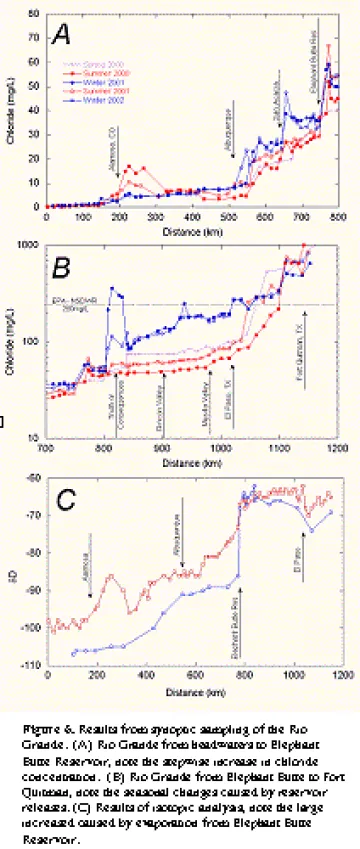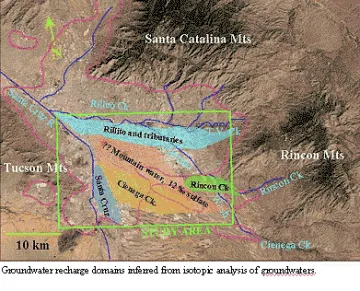Investigators: Fred Phillips, James Hogan, Jan Hendrickx
Graduate Students: Suzanne Mills, Naomi Roseneau
Overview
The quality of available water is as significant a problem as the availability of water in many arid-region drainage basins. River salinity commonly increases downstream. The origins of this increase in salinity are often difficult to determine. Potential salinity sources include atmospheric deposition, saline groundwater, anthropogenic sources, soil leaching in irrigated areas, and evapotranspirative concentration of the water. A comprehensive understanding of the sources of salinity and the processes affecting its increase are necessary for basin-scale salinity management. The example of the Murray/Darling Basin (sidebar) shows how even apparently benign human activities, such as clearing land for grazing, can result in damaging long-term fluctuations in water quality that may ultimately threaten sustainable use.
The water quality of the Rio Grande, like many arid region rivers, degrades with distance downstream. In particular, salinity levels limit the municipal and industrial use of the Rio Grande in the El Paso region. The causes of salinization are often complex, with multiple natural (saline groundwater, hydrothermal springs, and dissolution of evaporite deposits) and anthropogenic (agricultural return flow and wastewater from sewage treatment plants) sources, in addition to the concentrating effect of evapotranspiration. A comprehensive understanding of the sources of salinity and the processes affecting its increase are necessary for basin-scale salinity management. For the past three years we have conducted twice-annual synoptic sampling of the Rio Grande. We have employed a variety of environmental tracers to separate different salinity sources as well as the effects of evapotranspiration. Our research is focused around the following questions:
- What are the major sources of solutes and how are they partitioned between natural and anthropogenic origins?
- What are the relative roles of solute input and evapotranspirative concentration in producing the observed salinity in the lower basin?
- What is the solute-burden history of the river basin and why has it varied in time?
- Are significant transients in solute burden likely in the future?
- What management alternatives are available for reducing salinity?
The immediate goal of this research project is to identify and quantify the sources of salinity to the Rio Grande. The long-term goal of this research is to develop a water/solute mass balance model for the Rio Grande that is capable of modeling past temporal variation and can investigate future-use scenarios.
Activities and Results
We have conducted five synoptic samplings of the Rio Grande. During these sampling campaigns roughly 100 sites were sampled along the river. Samples were analyzed in the field for TDS, EC, pH and in the laboratory for Cl and Br concentrations. Salinity increases in a stepwise fashion, with roughly five localized sections of the river where there are significant increases, that is remarkably consistent with minimal seasonal or interannual variability (Figure 6A and 6B). Some of these increases are correlated with known sources (agricultural drains, hydrothermal areas). Others are not correlated with known discharges but occur at the lower end of sedimentary basins leading to the speculation that they are the result of discharge of deep, saline, groundwaters. Of particular interest is the Albuquerque basin where, in two distinct steps, the TDS of the river doubles from ~150 mg/L to ~300 mg/L and Cl increases from ~10 mg/L to 30-40 mg/L (Figure 6A). With little change in river discharge for this reach, this represents a significant increase in the solute burden of the river. We have used several solute ratios (e.g. Cl/Br, Ca/Sr, Cl/SO4) in conjunction with a two component mixing - evaporation model to study the solute balance of the Rio Grande. Results indicate the importance of solute inputs, especially from Albuquerque to Elephant Butte Reservoir where ~60% of the solutes enter the system.

During the past 10 months much of our focus has been on applying isotopic tracers to "fingerprint" and quantify the sources of solutes at these locations. We are currently employing four solute isotopic systems: (1) 87Sr/86Sr in collaboration with J. Ruiz at University of Arizona; (2) 36Cl/Cl at the PRIME Lab facility; (3) d32S in collaboration with C. Eastoe; and (4) d11B in collaboration with C.P. Chamberlain at Stanford University. In addition, samples have been analyzed for oxygen and hydrogen isotopes (with C. Eastoe) (Figure 6C). Oxygen and hydrogen isotopes reveal the importance of evaporation, especially from reservoirs. Preliminary results from solute isotope systems do "fingerprint" saline groundwaters as the solute source (e.g. low 36Cl/Cl and high 87Sr/86Sr ratios). In order to quantify saline groundwater inputs, one must understand the chemical composition of the groundwater system. In order to do this we have developed partnerships with the USGS (Albuquerque basin), New Mexico Interstate Stream Commission (Socorro basin), and through SAHRA's partnership with CEA-CREST (Project 2.9: Hueco Bolson - El Paso area). We are currently in the process of analyzing end member groundwater samples obtained through these partnerships.
Finally, during the past reporting period we have begun our efforts on dynamic simulation modeling. We started with modeling the Elephant Butte Reservoir system where we have observed increase in Cl concentration from ~40 to ~60 mg/L during our three years of sampling. The increase is clearly correlated with the decrease in storage volume during this same period. The situation allowed for a critical test of both water and solute mass balance modeling. We developed a model covering the period from 1997-2002 with a monthly time-step. Results of this initial model were successful. The water balance was easily modeled using USGS gauge data from surface water input and output in addition to simple precipitation and evaporation input. In order to successfully model the chloride mass balance we needed additional saline groundwater input into the reservoir.
 Study Area
Study Area
This study is focused on the Rio Grande above Fort Quitman Texas. The drainage area is just over 32,000 square miles. Within the upper Rio Grande drainage there are over one million inhabitants, mostly centered in the two large population centers of Albuquerque NM and El Paso TX. Irrigated agriculture is common along the Rio Grande. There are close to one million acres land currently being irrigated for agriculture along the length of the Rio Grande. The greatest concentration of agriculture occurs in the San Luis Valley, CO, Albuquerque Basin, NM, and Mesillia Valley NM.
Plans
Activities in the coming year will be focused on three goals:
- Wrap up the isotopic analysis. Determine the geochemical composition of saline groundwaters. Quantify saline groundwater fluxes using isotopic mass balance.
- Continue river sampling but with a reduced number of samples; the next sampling trip is planned for August 2002. We will continue to collect filtered samples for organic/nutrient analysis (3.9).
- Continue construction of a steady-state water/solute dynamic simulation model. Begin analysis of historic datasets using dynamic simulation model.
Long-term Plans and Goals
Our long-erm goals include the following:
- A detailed understanding of the sources, fluxes, and reservoirs of salinity in the basin.
- Pinpointing major salinity sources that could be diverted or ameliorated.
- Assessment of the likelihood of major salinity transients and their possible causes.
Integration with other SAHRA Activities

Research investigating solute sources and balances in the Rio Grande has close ties with several other SAHRA research projects (Figure 6). As described above, saline groundwaters are a potentially significant source of solutes to the Rio Grande. The work of Long and Eastoe, tracing groundwater flowpaths will provide a useful constraint on where saline groundwaters may discharge. Exploration of past variation and future scenarios with our solute mass balance model will be closely tied with Chris Duffy's work on low-dimensional models. Duffy's research investigates how long-term changes (climate, vegetation, human use) propagate through a basin hydrologic system and result in changes in river discharge and solute burden. The combined results of this work will be incorporated into a coarse resolution / lumped parameter systems model as part of the Integrated basin-scale modeling effort of TA4. Finally, this project has direct linkages to nutrient cycling in riparian areas (TA3) (nutrients are biologically important solutes) and to river management in TA5 (URGWOM Model, etc.).
This group has also developed several important collaborations outside of SAHRA specifically focused on developing partnerships with researchers working on the groundwater system of Rio Grande valley. As the Rio Grande travels from Colorado to Texas it passes through several sedimentary basins. Past research efforts have tended to be isolated and focused on one groundwater basin at a time. Our study represents the first attempt to gain a holistic understanding of salinity sources through all basins. In order to understand these sources one must also have an understanding of basin-scale groundwater systems. To this end we have developed partnerships with the USGS (Albuquerque basin) , New Mexico Interstate Stream Commission (Socorro basin) , and through SAHRA's new partnership with the CEA-CREAST (Hueco Bolson - El Paso area). It is our belief that by linking these groundwater basin studies with our sampling of the Rio Grande we will develop a holistic understanding of salinity sources to the Rio Grande. Finally, the isotopic analyses of the Rio Grande will be incorporated into the International Atomic Energy Agency's (IAEA) worldwide investigation into isotopic mass balances for river basins.
Publications and Presentations
- James F. Hogan, Fred M. Phillips, Suzanne K. Mills, Jan M.M. Hendrickx, John Villinski, Chris Eastoe, Paul Brooks, and Joquin Ruiz, Rio Grande Water Quality: An Integrated Basin-Scale View, SAHRA 2002 Annual Meeting, Tucson, Arizona, March 2002.
- Suzanne K. Mills, Fred M. Phillips, James Hogan, and Jan M.H. Hendrickx, The Salt of the Earth: Using Environmental Tracers to Quantify Causes of Salinity in semi-Arid Region Basins, Preliminary Results from the Rio Grande, SAHRA 2002 Annual Meeting, Tucson, Arizona, March 2002.
- Hogan, J., F. M. Phillips and J.M.M. Hendrickx, Solute Sources and Budget for the Rio Grande above El Paso, Texas, AGU Fall Meeting, San Francisco, CA, December, 2001.
- Phillips, F.M., Hogan, J., Mills, S.K., and Hendrickx, J.M.H., Environmental Tracers for Assessing Water and Salt Balances in Arid-Region River Basins (invited abstract) Dubai International Conference On Water Resources and Integrated Management in the Third Millenium, Dubai, UAE, February, 2002.
- Roseneau, N. and F.M. Phillips, Chloride/ bromide ratios in the Rio Grande, Poster Presentation at the SAHRA Annual Meeting, Tucson, AZ, February, 2001.
- Springer E. P., C. J. Duffy, F. M. Phillips, J. Hogan, and C. L. Winter, The Upper Rio Grande Basin as a Long-Term Hydrologic Observatory - Challenges and Opportunities, AGU Fall Meeting, San Francisco, CA, December, 2001.
